Operation of police powers under the Terrorism Act 2000 and subsequent legislation: Arrests, outcomes and stops and search, Great Britain, quarterly update to September 2016
Published 15 December 2016
Applies to England, Scotland and Wales
1. Key findings
1.1 Arrests and outcomes
Arrests for terrorism-related offences fell by a fifth in the year ending 30 September 2016 compared with the previous year (from 317 to 255 arrests). Although the number of arrests has fallen, it is still relatively high when compared to other recent years.
There was a change in the gender of those arrested, with a fall in the proportion of those arrested who were female, from 16% in the year ending September 2015 to 11% in the year ending 30 September 2016.
1.2 Court proceedings
In the year ending 30 September 2016, 67 trials were completed by the Crown Prosecution Service Counter Terrorism Division (CPS CTD). Of these, 61 (91%) led to a conviction. This was an increase on the previous year, when 51 trials were completed (42 of which led to a conviction).
There was an increase in the number of people receiving longer sentences in the year ending 30 September 2016 compared to the previous year, with those receiving sentences of between 4 and 10 years increasing from 8 to 25, and the number of life sentences given increasing from 1 to 9. The number of individuals receiving a sentence of less than 4 years fell from 28 to 19.
1.3 Terrorist and extremist/separatist prisoners
As at 30 September 2016, there were 178 persons in custody for terrorism-related offences and domestic extremism/separatism. This was an increase from 170 in custody as at 30 September 2015.
The number of persons in custody for domestic extremism/separatism has fallen in the year ending 30 September 2016 compared to the previous year (from 33 to 9), but this has been more than offset by an increase in number of individuals in custody for terrorism-related activity. This has steadily increased in recent quarters.
1.4 Other police powers under the Terrorism Act 2000
In the year ending September 2016:
- the Metropolitan Police Service (MPS) carried out 571 stops and searches under section 43 of the Terrorism Act (TACT) 2000, an increase of 20% compared with the previous year
- 11% of these searches led to an arrest, up from 8% in the previous year
- there were over 21,500 examinations carried out under Schedule 7 to TACT 2000, a fall of 25% compared with the previous year; this continues the recent downward trend
2. Introduction
2.1 Overview
This release covers the use of police powers under terrorism and terrorism-related legislation in Great Britain in the most recent 9 quarters to September 2016. The release is broken down into 4 sections.
The Arrests and outcomes section uses data provided by the National Counter Terrorism Policing Functions Command (NCTPFC) and includes statistics for Great Britain on:
- arrests for terrorism-related activity and outcomes (such as charges and convictions) following arrests
- the legislation used to bring charges and convictions
- gender, age, ethnicity and nationality of those arrested, charged and convicted
- the type of terrorism involvement of those arrested, charged and convicted (such as whether the individual had links to international, domestic, or Northern Ireland-related terrorism)
A flow chart summarising this section can be found in Annex A.
The Court proceedings section uses data from the CPS and includes statistics for England and Wales on:
- the number of persons proceeded against by the CPS for terrorism-related activity
- the legislation under which persons have been prosecuted and convicted
- the sentence length given to those convicted for terrorism-related offences
The Terrorist and extremist/separatist prisoners section uses data from the National Offender Management Service (NOMS) and the Scottish Prison Service (SPS) and includes statistics for Great Britain on:
- the number of persons in custody for domestic extremism and terrorism-related offences
- the ethnicity, nationality and religion of those in custody
- the number of persons released from custody
The Other police powers under the Terrorism Act 2000 section uses data provided by MPS and the National Counter Terrorism Policing Headquarters (NCTPHQ). It includes statistics on:
- the number of stops and searches carried out by MPS under s.43 of the Terrorism Act (TACT) 2000
- the number of examinations and subsequent detentions made in Great Britain under Schedule 7 to TACT 2000
- data on goods examinations, strip searches and postponement of questioning refusals under Schedule 7 to TACT 2000
The user guide provides further details on this release. It includes details on the strengths and limitations of the datasets, as well as the quality assurance processes involved in ensuring that the data meet the highest possible standard. It also includes a summary of the criminal justice process, a glossary of terms used in the publication, and more detailed information about the legislation and categories mentioned in this release.
A flow chart summarising the Arrests and outcomes section of this release can be found in Annex A.
3. Arrests and outcomes
3.1 Introduction
This section presents statistics on the number of persons arrested by police in Great Britain, where there is suspicion of involvement in a terrorism-related offence, either at the time of arrest or at a subsequent point in the investigation. In some cases, evidence may emerge after a terrorism-related arrest that suggests a suspect does not have links to terrorist activity, but has committed a non-terrorism-related offence. These cases are included in the data as non-terrorism-related charges and/or convictions.
Outcomes following arrests for terrorism-related offences are also included in the statistics and show the number of arrests that led to a charge or prosecution, as well as other outcomes. Demographic information about those arrested, charged and convicted is also provided in this section. All data in this section are based on the date of arrest. This allows users to see the outcomes of all of the arrests in a specific period (such as how many led to a charge and conviction).
As cases progress over time, figures are likely to change. This is particularly relevant for more recent time periods where a larger number of cases will be incomplete (‘released on bail’ or ‘awaiting prosecution’). While the effect on the arrests total should be minimal, the number of charges and convictions will be lower for more recent quarters as a greater number of cases would not have reached the point of charge or conviction yet. Figures for these quarters will increase in future publications as more cases are completed.
Data are provided to the Home Office by NCTPFC and are taken from a live database. This section includes quarterly breakdowns of the data from the 9 quarters to September 2016, as well as totals since 11 September 2001 (when the data collection began). The data are correct as at the time of provision to the Home Office (19 October 2016).
A flow chart summarising this section is included in Annex A. This follows individuals from the point of arrest through to charge (or other outcome) and prosecution. Data tables A.01 to A.13 include data on arrests and outcomes.
3.2 Arrests
In the year ending 30 September 2016, there were 255 arrests for terrorism-related offences in Great Britain, a fall of a fifth compared with 317 arrests in the previous year. As Figure 3.1 shows, this reflects a particularly high number of arrests in 2 of the quarters in the year to 30 September 2015 (rather than a low number of arrests in the most recent year). The number of arrests in the year to 30 September 2016 was still relatively high compared to other recent years (Figure 3.2).
Figure 3.1: Arrests for terrorism-related offences, by legislation, Great Britain1

Alt text not supplied by author.
Source: NCTPFC (see data table A.01).
Notes:
- ‘Other legislation’ includes arrests under non-terrorism legislation, such as the Police and Criminal Evidence Act 1984.
Figure 3.2: Arrests for terrorism-related offences, Great Britain1

Alt text not supplied by author.
Source: NCTPFC (see data table A.01).
Notes:
- Figures for the year ending 31 March 2002 include data from 11 September onwards only.
- ‘Other legislation’ includes arrests under non-terrorism legislation, such as the Police and Criminal Evidence Act 1984.
3.3 Charges
In line with the normal procedures for criminal justice statistics, each suspect has been classified in terms of a single principal offence. This means that when an individual is charged with a number of offences at the same time, they are recorded only against the most serious one – usually the one that carries the highest penalty. This means that the figures count the number of individuals charged, rather than the number of individual offences committed that led to a charge. Further details of the legislation under which persons have been charged following an arrest for a terrorism-related offence can be found in data tables A.05a-c.
Of the 255 arrests for terrorism-related offences in the year ending 30 September 2016, 96 had resulted in a charge by 19 October 2016 (78 terrorism-related and 18 non-terrorism-related). In 78 cases, the individual had been released without charge; in a further 73 cases, the arrestee was released on bail pending further investigation.
More recent quarters have a larger proportion of cases where individuals have been bailed to return, as shown in Figure 3.3. As time progresses, these cases will eventually lead to a charge, release, or alternative action; as a result charge rates will change over time. Until all cases in a given period are complete, caution should be taken when comparing charge rates over time.
Figure 3.3: Charging outcomes following an arrest for a terrorism-related offence, Great Britain
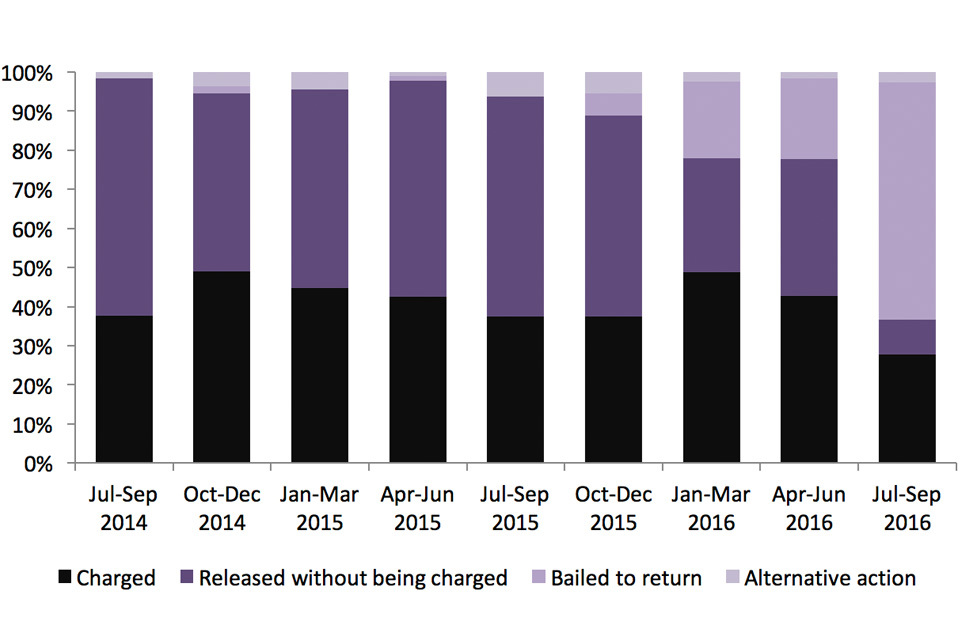
Alt text not supplied by author.
Source: NCTPFC (see data table A.03).
Notes:
- ‘Alternative action’ includes cautions for non-TACT offences, detentions under the mental health act, recall to prison, etc.
- ‘Bailed to return’ includes those released on bail pending further investigation, and those who have absconded from bail.
Of the 96 charges resulting from an arrest in the year ending 30 September 2016, 81% (78) were for a terrorism-related offence, a fall compared with 89% in the year ending 30 September 2015. As a number of cases are still incomplete, these proportions are likely to change as cases progress.
3.4 Prosecutions
As with the data on charges, prosecutions data are also based on the principal offence rule. Where an individual is prosecuted for more than one offence at a time, they are classified in terms of a single offence; usually the most serious. Further details of the legislation under which persons have been convicted following a charge for a terrorism-related offence can be found in data tables A.08a-c.
Of the 78 persons charged with a terrorism-related offence in the year ending 30 September 2016, 28 had been prosecuted (as at 19 October 2016), 27 of which were found guilty. A further 48 were awaiting prosecution.
Figure 3.4: Outcomes following a charge for a terrorism-related offence, Great Britain, year ending 30 September 20161,2,3,4

Alt text not supplied by author.
Source: NCTPHQ (see data table A.06c).
Notes:
- Based on time of arrest.
- A more detailed flow chart can be found in Annex A.
- Data presented are based on the latest position with each case as at the date of data provision from NCTPFC (19 October 2016).
- The chart does not include outcomes following non-terrorism-related charges.
- Terrorism-related charges and convictions include some charges and convictions under non-terrorism legislation, where the offence is considered to be terrorism-related.
- Cases that are ‘awaiting prosecution’ are not yet complete. As time passes, these cases will eventually lead to a prosecution, ‘other’ outcome, or it may be decided that the individual will not be proceeded against.
- Excludes convictions that were later quashed on appeal.
3.5 Demographics of persons arrested
This section includes statistics on the number of persons arrested by different demographic characteristics as well as terrorist categorisation. It includes data on:
- gender
- age
- ethnic appearance
- nationality
- terrorist category
Gender
In the year ending 30 September 2016, 29 females were arrested for terrorism-related offences, which accounted for 11% of all arrests. This was 5 percentage points lower than the previous year, when females accounted for 16% of all arrests for terrorism-related offences. The number of female arrests fell from 50 in the year ending 30 September 2015 to 29 in the latest year.
Figure 3.5: Arrests for terrorism-related offences by sex, Great Britain
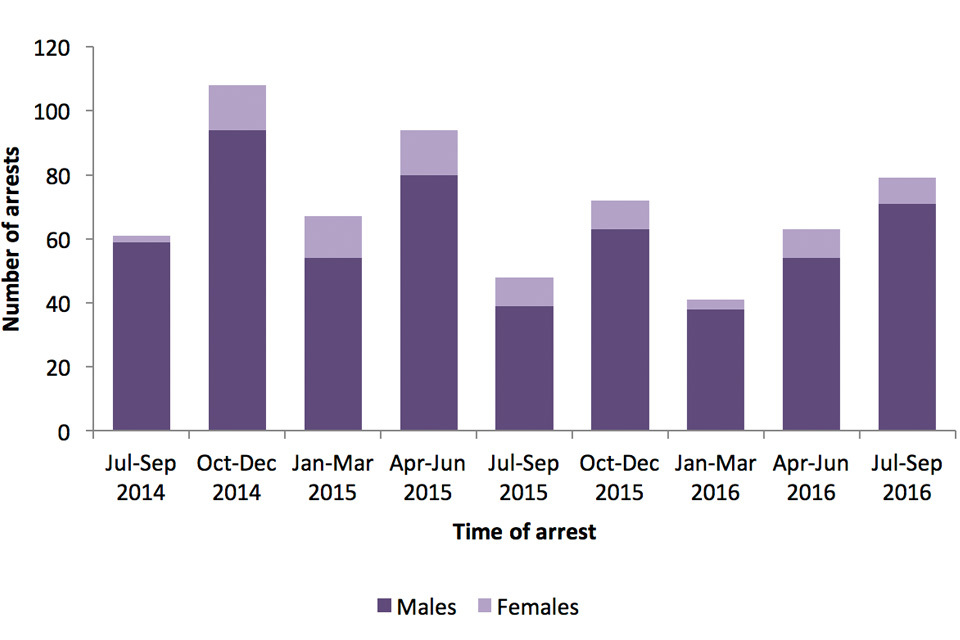
Alt text not supplied by author.
Source: NCTPFC (see data table A.09).
Age
In the year ending 30 September 2016, there were falls in the number of arrests across all age groups compared with the previous year, with the exception of under-18s (which remained the same). As in the previous year, the 30 and over age group accounted for the most arrests (53%).
Ethnic appearance
The number of arrests fell across all ethnic groups except the ‘other’ group, which increased by 12 in the year ending 30 September 2016 compared with the previous year. The biggest fall was seen for those of Asian ethnic appearance, with a fall of 57 arrests. This partly reflects the fact that this group accounted for the largest proportion of arrests (just under half). However, the percentage fall in arrests in this group was also greater than the national fall.
Figure 3.6: Ethnic appearance of persons arrested for terrorism-related offences, year ending 30 September 2016 compared with year ending 30 September 2015
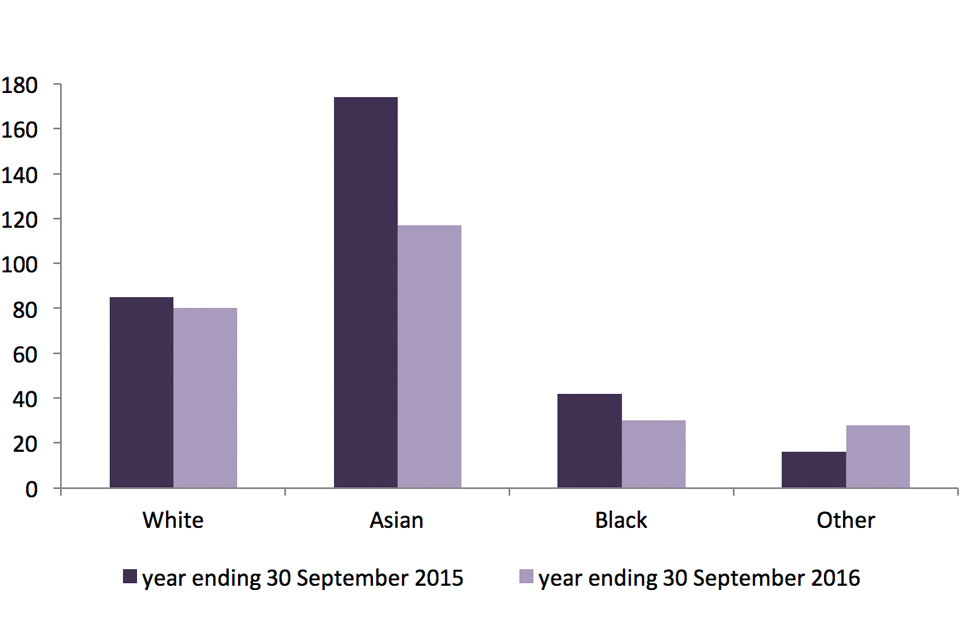
Alt text not supplied by author.
Source: NCTPFC (see data table A.11).
Nationality
Just under three-quarters (71%) of those arrested in the year ending 30 September 2016 considered themselves to be of British or British dual nationality. This was down 9 percentage points compared with the previous year. Since 11 September 2001 (when the data collection began), 56% of those arrested considered themselves to be of British or British dual nationality.
Terrorist category
When an individual is arrested, they are categorised according to the type of terrorism they are involved in. They may be categorised as either ‘international’, ‘domestic’, ‘Northern Ireland-related’ or ‘not classified’. Definitions for each of these categories can be found in the user guide.
In the year ending 30 September 2016, the number of persons arrested for international terrorism fell by 13% (from 241 arrests to 210) compared with the previous year. Across the same period, the number of persons arrested for domestic terrorism fell from 27 to 19.
Figure 3.7: Proportion of persons arrested by terrorism category, year ending 30 September 2016, Great Britain
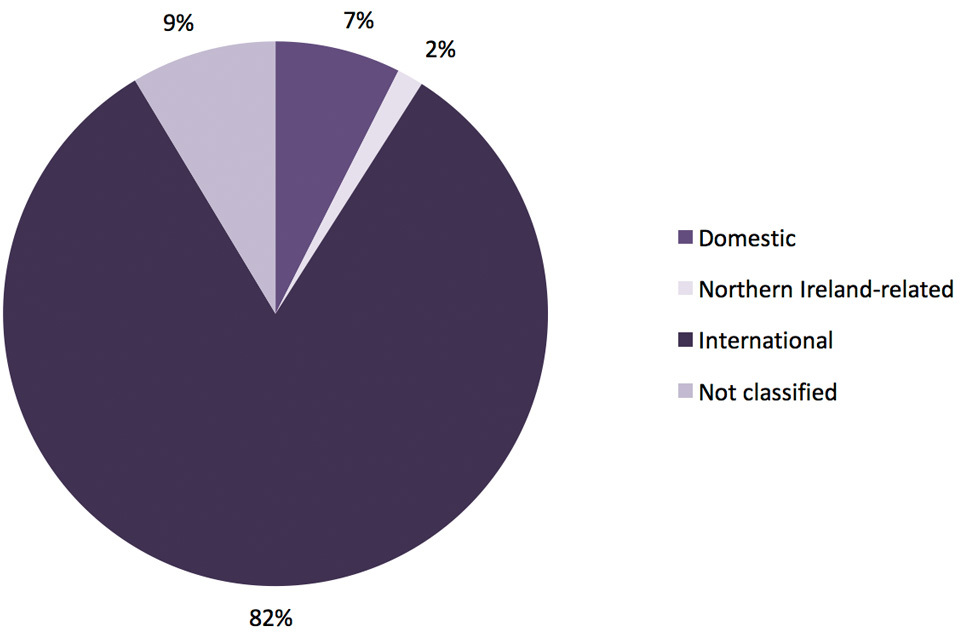
Alt text not supplied by author.
Source: NCTPFC (see data table A.13).
3.6 Data tables
Additional data are available in the data tables which accompany this release. These include more detailed breakdowns of the data in this section, as well as data on:
- detentions under section 41 of TACT 2000 table A.02
- the legislation under which persons were charged table A.05a-c
- the legislation under which persons were convicted tables A.08a-c
4. Court proceedings
4.1 Introduction
This section presents statistics on prosecutions for terrorism-related offences in England and Wales. It provides data on the number of persons prosecuted and convicted, including information on the legislation against which they were prosecuted. It also provides information on the length and type of sentence that each defendant faces. Data in this section are based on the trial completion date and are not directly comparable to the prosecutions data in Section 3, Arrests and outcomes.
Data are provided to the Home Office by the Crown Prosecution Service Counter Terrorism Division (CPS CTD). The data cover terrorism-related court cases that were completed in the last 9 quarters up to 30 September 2016.
4.2 Court proceedings
In the year ending 30 September 2016, there were 67 trials completed by the CPS CTD for terrorism-related offences. This was 16 more than the 51 trials completed in the previous year, driven mainly by a large increase (from 13 to 30) in the number of persons proceeded against for preparation for terrorist acts. Of the total of 67 persons proceeded against, 61 (91%) were convicted. In the remaining 6 cases the defendant was acquitted.
Figure 4.1: Outcome of terrorism-related trials under TACT and non-TACT legislation1, year ending 30 September 2016, England and Wales
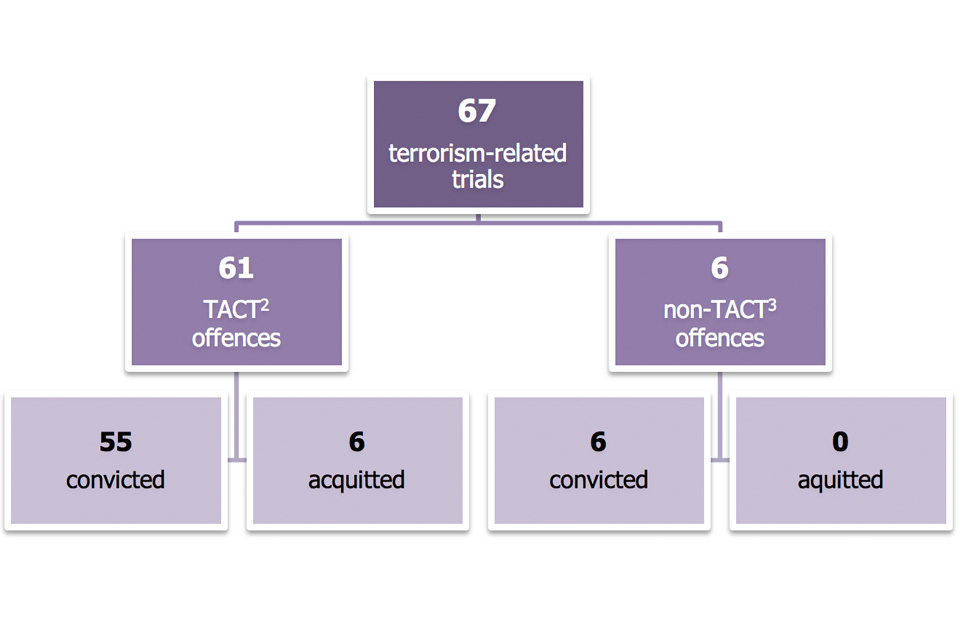
Alt text not supplied by author.
Source: CPS CTD data tables C.01-C.03.
Chart Notes:
- Based on the principal offence for which the defendant was prosecuted against.
- TACT offences include offences specifically under terrorism legislation.
- Non-TACT offences include offences under other legislation.
- Can include trials ending in a hung jury, or where the prosecution offered no evidence.
4.3 Sentencing
Of the 61 persons convicted of terrorism-related offences in the year ending 30 September 2016, 21 (34%) pleaded guilty and 40 entered a not-guilty plea. In the previous year, 27 of the 42 persons convicted (64%) entered a guilty plea.
The biggest increase was in the number of individuals sentenced for between 4 and 10 years, which increased from 8 in the year ending 30 September 2015 to 25 in the year ending 30 September 2016. The number of individuals who received a life sentence also increased from 1 to 9. This may indicate a trend towards more serious offences being committed, or be due to similar offences receiving a longer sentence than in previous years.
Figure 4.2 Sentence length for persons convicted of terrorism-related offences, year ending 30 September 2015 and 30 September 2016, England and Wales
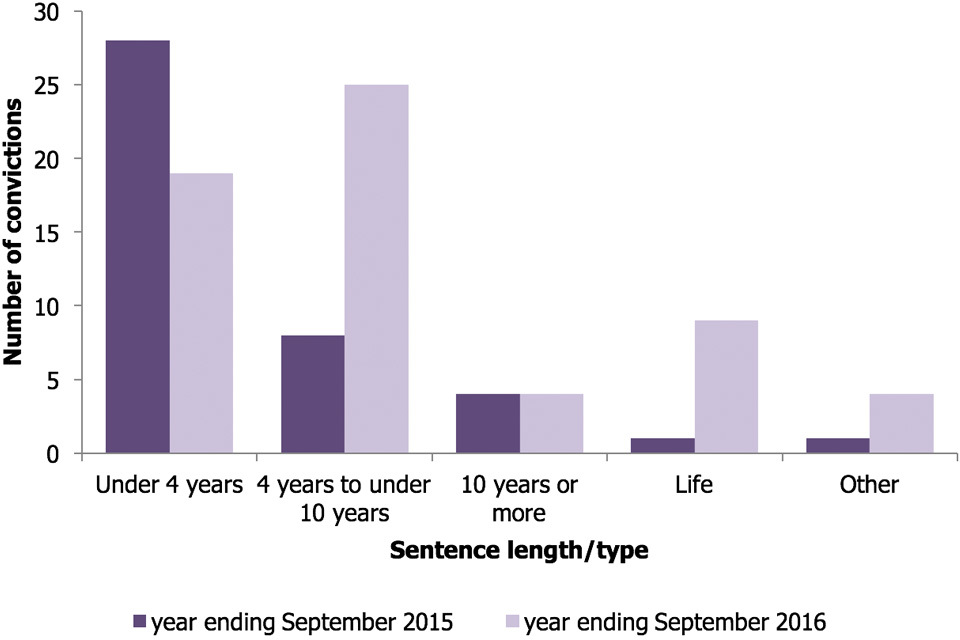
Alt text not supplied by author.
Source: CPS CTD data tables C.04.
Chart Notes:
- Based on the trial completion date.
- The ‘other’ category includes hospital orders and non-custodial sentences.
4.4 Data tables
Additional data are available in tables C.01 to C.04 which accompany this release. These include more detailed breakdowns of the data in this section, as well as data on:
- the legislation under which persons were proceeded against table C.02
- the legislation under which persons were convicted table C.03
5. Terrorist and extremist/separatist prisoners
5.1 Introduction
Statistics presented in this section give information on the number of persons in custody for terrorism-related offences and domestic extremism/separatism in Great Britain. It includes breakdowns of the ethnicity, nationality and religion of prisoners at a given time. Data on the number of terrorist and extremist/separatist prisoners released from custody are also available in this section.
Data are provided to the Home Office by NOMS and the SPS. The data give information about the prison population at the end of the last 9 quarters to 30 September 2016. Data on the number of prisoners released are also provided and cover the 8 quarters to 30 June 2016. Figures up to September 2016 are not yet available from NOMS. These figures will form a subset of the prison releases statistics which will be published by the Ministry of Justice in their Offender Management Statistics Quarterly release in January 2017.
5.2 Persons in custody
As at 30 September 2016, there were 178 persons in custody in Great Britain for both terrorism-related (169) and domestic extremism/separatism (9) offences.
Of those in custody, the majority (76%) had been convicted. The remaining 24% were being held on remand (held in custody until a later date when a trial or sentencing hearing will take place).
The 178 prisoners in custody for terrorism-related and domestic extremism/separatism offences at 30 September 2016 was an increase on the 170 persons in custody as at 30 September 2015. The fall in the number of domestic extremist/separatist prisoners (from 33 to 9) was more than offset by the rise in the number of persons in custody for offences under terrorism legislation, which increased from 137 to 169 over the same period.
Figure 5.1: Number of persons in custody for terrorism-related offences and domestic extremism/separatism, Great Britain

Alt text not supplied by author.
Source: NOMS and SPS (see data table P.01).
5.3 Persons released from custody
A total of 89 prisoners held for terrorism-related and domestic extremism/separatism offences were released from custody in Great Britain in the year ending 30 June 2016. Of these, 56 (63%) were persons discharged from custody after serving their sentences, many of whom will have been released subject to meeting certain licence conditions.
A large number (40) of the 89 released had sentence lengths of less than 4 years. A further 33 were not sentenced, which includes a number of persons held on remand prior to a charge or conviction. For more details on releases from custody, see the user guide.
5.4 Data tables
Additional data are available in tables P.01 to P.05 which accompany this release. These include more detailed breakdowns on:
- the ethnicity, nationality and religion of those in custody tables P.02 to P.04
- the sentence lengths of those released from custody table P.05
6. Other police powers under the Terrorism Act 2000
6.1 Introduction
This section presents statistics on the use of stop and search powers available to the police under TACT 2000. It includes data on the number of stops and searches and resultant arrests carried out by MPS under s.43 of TACT 2000. It also includes data on the use of powers under Schedule 7 to TACT 2000 in Great Britain. This includes the number of examinations, resultant detentions, sea and air freight examinations, strip searches, and the number of times postponement of questioning was refused.
Data on s.43 stop and search are provided to the Home Office by MPS. Data on Schedule 7 are provided to the Home Office by NCTPHQ. This section covers the use of these powers in each of the last 9 quarters up to 30 September 2016.
The police have the power to stop and search individuals under s.47A (previously 44) of TACT 2000. However, since the legislation was formally amended in 2011 to significantly raise the threshold for authorisation of the power, there have not been any stops and searches under this power in Great Britain. See the user guide for more details.
6.2 Stop and search under the Terrorism Act 2000
Section 43 of TACT 2000 allows a constable to stop and search a person whom he/she reasonably suspects to be involved in terrorist activity. As many forces are unable to separate s.43 TACT stops and searches from other stops and searches, this section includes data from MPS only and excludes ‘vehicle only’ stops and searches.
In the year ending 30 September 2016, 571 persons were stopped and searched by MPS under s.43 of TACT 2000. This represents a rise of 20% on the previous year’s total of 474. Across the same period, the number of resultant arrests has increased by 50%, from 40 to 60. This has led to an increase in arrest rate from 8% in the year ending 30 September 2015 to 11% in the latest year.
Details on the use of other stop and search powers in England and Wales up to the year ending 31 March 2016 can be found in the Home Office police powers and procedures, England and Wales statistical release. The MPS also publish monthly reports on the wider use of stop and search within the force.
Figure 6.1: Stops and searches under s.43 of TACT 2000, MPS

Alt text not supplied by author.
Source: MPS (see data table S.01).
Chart Notes:
- Excludes ‘vehicle only’ searches.
The number of stops increased across all ethnic groups, except for those who considered themselves to be Black or Black British (which fell by 1). One of the largest numerical increases was seen for searches on those who considered themselves to be Asian, which increased by 15% (or 19 searches). There was also a rise of 69% (or 46 searches) for those who did not state their ethnicity.
6.3 Schedule 7 to the Terrorism Act 2000
Under Schedule 7 to TACT 2000, an examining officer has a number of powers, the uses of which are covered in this section. These include:
- examinations of persons and resultant detentions
- goods examinations
- strip searches
- refusals to postpone questioning
Examinations and resultant detentions
An examining officer may stop and question individuals entering or leaving the country through ports, airports, international rail stations and the border area. When necessary they may also detain and search individuals. The aim is to determine whether that person appears to be someone who is or has been concerned in the commission, preparation or instigation of acts of terrorism.
In the year ending 30 September 2016, a total of 21,651 persons were examined under this power in Great Britain, a fall of 25% from the previous year. This continued the gradual decline in the use of the power in recent years.
Throughout the same period, the number of detentions following examinations decreased by 8%, from 1,810 in the year ending 30 September 2015 to 1,665 in the year ending 30 September 2016. This was the first fall in the number of detentions since the introduction of the Anti-social Behaviour, Crime and Policing Act 2014, which amended the powers under Schedule 7 to TACT 2000 to ensure a mandatory detention takes place where an examination lasts for more than 1 hour. The Act has now been in place for over 2 years, and so year-on-year trends in detentions are less likely to be influenced by its introduction.
Figure 6.2: Number of Schedule 7 examinations and resultant detentions, Great Britain
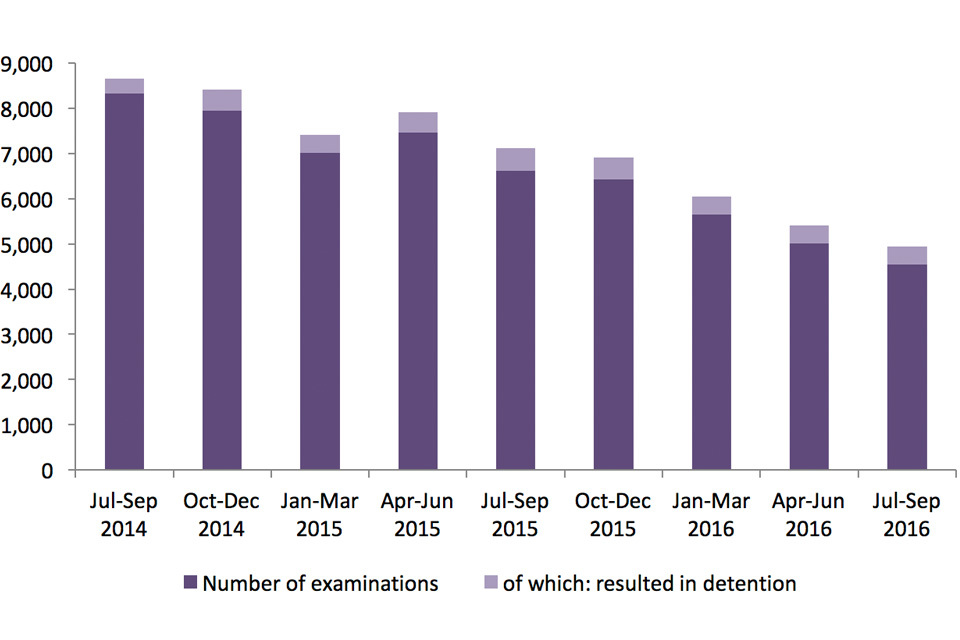
Alt text not supplied by author.
Source: NCTPHQ (see data table S.04).
In the year ending 30 September 2016, of all examinations (excluding those where ethnicity was not stated), 29% were of ‘White’ ethnicity. This was down 4 percentage points on the previous year. The proportion of examinations on those who were of ‘Asian or Asian British’ or ‘Chinese or other’ ethnicity increased by 3 percentage points each.
Table 6.1 Proportion and number of examinations accounted for by each ethnic group, year ending 30 September 2015 compared with year ending 30 September 2016
| Ethnicity | Year ending September 2015 | Year ending September 2016 |
|---|---|---|
| White | 33% (8,934) | 29% (5,532) |
| Asian or Asian British | 30% (8,264) | 33% (6,327) |
| Chinese or other | 23% (6,179) | 26% (5,118) |
| Black or Black British | 8% (2,185) | 8% (1,609) |
| Mixed | 6% (1,642) | 4% (791) |
Source: NCTPHQ (see data table S.04).
Table Notes:
- Excludes cases where ethnicity was not stated.
6.4 Other powers under Schedule 7 to the Terrorism Act 2000
The following section includes information on a number of additional powers under Schedule 7 to TACT 2000. This includes:
- goods examinations (sea and air freight)
- strip searches
- postponement of questioning refusals
Data on these powers have been collected by the Home Office since April 2015. Details on each of these powers can be found in the user guide.
In the year ending 30 September 2016:
- a total of 3,829 air freight and 6,415 sea freight examinations were conducted in Great Britain; the April to June 2016 quarter saw a particularly large number of sea freight examinations as a result of a number of national campaigns that were in operation during that period
- there were 6 strip searches carried out under the power
- postponement of questioning (usually to enable an individual to consult a solicitor) was refused 4 times
6.5 Data tables
Additional data are available in tables S.01 to S.04 which accompany this release. These include more detailed breakdowns on:
- the ethnicity of those stopped and searched tables S.02 and S.03
- the use of powers under Schedule 7 to TACT 2000 table S.04
